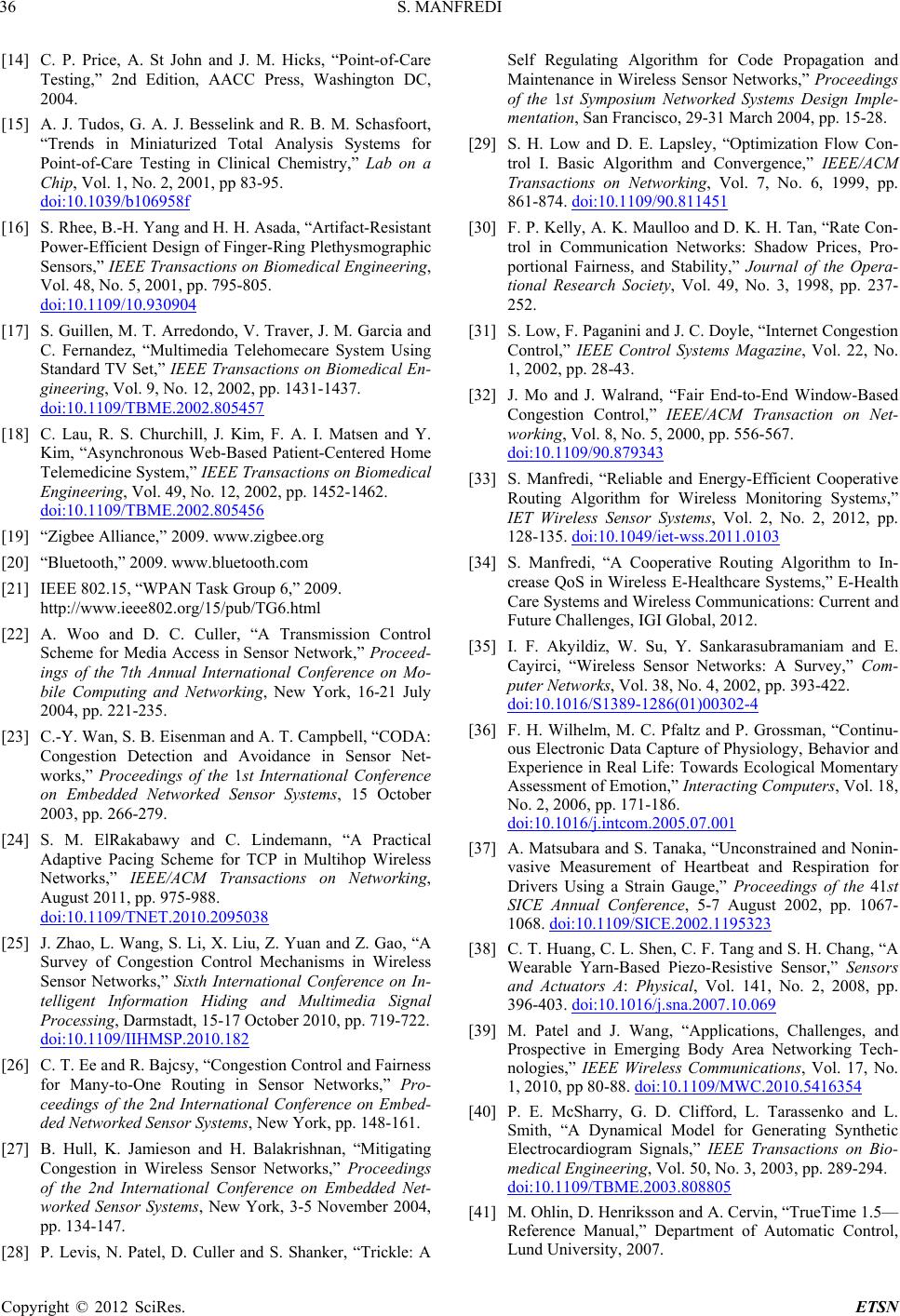
S. MANFREDI
36
[14] C. P. Price, A. St John and J. M. Hicks, “Point-of-Care
Testing,” 2nd Edition, AACC Press, Washington DC,
2004.
[15] A. J. Tudos, G. A. J. Besselink and R. B. M. Schasfoort,
“Trends in Miniaturized Total Analysis Systems for
Point-of-Care Testing in Clinical Chemistry,” Lab on a
Chip, Vol. 1, No. 2, 2001, pp 83-95.
doi:10.1039/b106958f
[16] S. Rhee, B.-H. Yang and H. H. Asada, “Artifact-Resistant
Power-Efficient Design of Finger-Ring Plethysmographic
Sensors,” IEEE Transactions on Biomedical Engineering,
Vol. 48, No. 5, 2001, pp. 795-805.
doi:10.1109/10.930904
[17] S. Guillen, M. T. Arredondo, V. Traver, J. M. Garcia and
C. Fernandez, “Multimedia Telehomecare System Using
Standard TV Set,” IEEE Transactions on Biomedical En-
gineering, Vol. 9, No. 12, 2002, pp. 1431-1437.
doi:10.1109/TBME.2002.805457
[18] C. Lau, R. S. Churchill, J. Kim, F. A. I. Matsen and Y.
Kim, “Asynchronous Web-Based Patient-Centered Home
Telemedicine System,” IEEE Transactions on Biomedical
Engineering, Vol. 49, No. 12, 2002, pp. 1452-1462.
doi:10.1109/TBME.2002.805456
[19] “Zigbee Alliance,” 2009. www.zigbee.org
[20] “Bluetooth,” 2009. www.bluetooth.com
[21] IEEE 802.15, “WPAN Task Group 6,” 2009.
http://www.ieee802.org/15/pub/TG6.html
[22] A. Woo and D. C. Culler, “A Transmission Control
Scheme for Media Access in Sensor Network,” Proceed-
ings of the 7th Annual International Conference on Mo-
bile Computing and Networking, New York, 16-21 July
2004, pp. 221-235.
[23] C.-Y. Wan, S. B. Eisenman and A. T. Campbell, “CODA:
Congestion Detection and Avoidance in Sensor Net-
works,” Proceedings of the 1st International Conference
on Embedded Networked Sensor Systems, 15 October
2003, pp. 266-279.
[24] S. M. ElRakabawy and C. Lindemann, “A Practical
Adaptive Pacing Scheme for TCP in Multihop Wireless
Networks,” IEEE/ACM Transactions on Networking,
August 2011, pp. 975-988.
doi:10.1109/TNET.2010.2095038
[25] J. Zhao, L. Wang, S. Li, X. Liu, Z. Yuan and Z. Gao, “A
Survey of Congestion Control Mechanisms in Wireless
Sensor Networks,” Sixth International Conference on In-
telligent Information Hiding and Multimedia Signal
Processing, Darmstadt, 15-17 October 2010, pp. 719-722.
doi:10.1109/IIHMSP.2010.182
[26] C. T. Ee and R. Bajcsy, “Congestion Control and Fairness
for Many-to-One Routing in Sensor Networks,” Pro-
ceedings of the 2nd International Conference on Embed-
ded Networked Sensor Systems, New York, pp. 148-161.
[27] B. Hull, K. Jamieson and H. Balakrishnan, “Mitigating
Congestion in Wireless Sensor Networks,” Proceedings
of the 2nd International Conference on Embedded Net-
worked Sensor Systems, New York, 3-5 November 2004,
pp. 134-147.
[28] P. Levis, N. Patel, D. Culler and S. Shanker, “Trickle: A
Self Regulating Algorithm for Code Propagation and
Maintenance in Wireless Sensor Networks,” Proceedings
of the 1st Symposium Networked Systems Design Imple-
mentation, San Francisco, 29-31 March 2004, pp. 15-28.
[29] S. H. Low and D. E. Lapsley, “Optimization Flow Con-
trol I. Basic Algorithm and Convergence,” IEEE/ACM
Transactions on Networking, Vol. 7, No. 6, 1999, pp.
861-874. doi:10.1109/90.811451
[30] F. P. Kelly, A. K. Maulloo and D. K. H. Tan, “Rate Con-
trol in Communication Networks: Shadow Prices, Pro-
portional Fairness, and Stability,” Journal of the Opera-
tional Research Society, Vol. 49, No. 3, 1998, pp. 237-
252.
[31] S. Low, F. Paganini and J. C. Doyle, “Internet Congestion
Control,” IEEE Control Systems Magazine, Vol. 22, No.
1, 2002, pp. 28-43.
[32] J. Mo and J. Walrand, “Fair End-to-End Window-Based
Congestion Control,” IEEE/ACM Transaction on Net-
working, Vol. 8, No. 5, 2000, pp. 556-567.
doi:10.1109/90.879343
[33] S. Manfredi, “Reliable and Energy-Efficient Cooperative
Routing Algorithm for Wireless Monitoring Systems,”
IET Wireless Sensor Systems, Vol. 2, No. 2, 2012, pp.
128-135. doi:10.1049/iet-wss.2011.0103
[34] S. Manfredi, “A Cooperative Routing Algorithm to In-
crease QoS in Wireless E-Healthcare Systems,” E-Health
Care Systems and Wireless Communications: Current and
Future Challenges, IGI Global, 2012.
[35] I. F. Akyildiz, W. Su, Y. Sankarasubramaniam and E.
Cayirci, “Wireless Sensor Networks: A Survey,” Com-
puter Networks, Vol. 38, No. 4, 2002, pp. 393-422.
doi:10.1016/S1389-1286(01)00302-4
[36] F. H. Wilhelm, M. C. Pfaltz and P. Grossman, “Continu-
ous Electronic Data Capture of Physiology, Behavior and
Experience in Real Life: Towards Ecological Momentary
Assessment of Emotion,” Interacting Computers, Vol. 18,
No. 2, 2006, pp. 171-186.
doi:10.1016/j.intcom.2005.07.001
[37] A. Matsubara and S. Tanaka, “Unconstrained and Nonin-
vasive Measurement of Heartbeat and Respiration for
Drivers Using a Strain Gauge,” Proceedings of the 41st
SICE Annual Conference, 5-7 August 2002, pp. 1067-
1068. doi:10.1109/SICE.2002.1195323
[38] C. T. Huang, C. L. Shen, C. F. Tang and S. H. Chang, “A
Wearable Yarn-Based Piezo-Resistive Sensor,” Sensors
and Actuators A: Physical, Vol. 141, No. 2, 2008, pp.
396-403. doi:10.1016/j.sna.2007.10.069
[39] M. Patel and J. Wang, “Applications, Challenges, and
Prospective in Emerging Body Area Networking Tech-
nologies,” IEEE Wireless Communications, Vol. 17, No.
1, 2010, pp 80-88. doi:10.1109/MWC.2010.5416354
[40] P. E. McSharry, G. D. Clifford, L. Tarassenko and L.
Smith, “A Dynamical Model for Generating Synthetic
Electrocardiogram Signals,” IEEE Transactions on Bio-
medical Engineering, Vol. 50, No. 3, 2003, pp. 289-294.
doi:10.1109/TBME.2003.808805
[41] M. Ohlin, D. Henriksson and A. Cervin, “TrueTime 1.5—
Reference Manual,” Department of Automatic Control,
Lund University, 2007.
Copyright © 2012 SciRes. ETSN